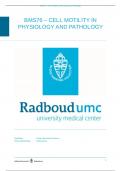Summary
Samenvatting - BMS76 - Cell motility in physiology and pathology (BMS76) Summary
- Course
- Institution
Deze samenvatting bevat alle onderwerpen behandeld tijdens het master vak BMS76- Cell motility in physiology and pathology (actin organization/dynamics, polarization, protrusion, adhesion, contraction, tail retraction, environmental guidance of cell movement, haptokinesis, haptotaxis, chemotaxis, t...
[Show more]



